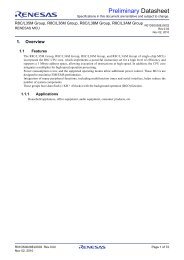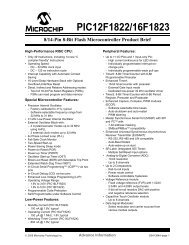xmega a3u - Elfa
xmega a3u - Elfa
xmega a3u - Elfa
Create successful ePaper yourself
Turn your PDF publications into a flip-book with our unique Google optimized e-Paper software.
XMEGA A3U<br />
11. Power Management and Sleep Modes<br />
11.1 Features<br />
• Power management for adjusting power consumption and functions<br />
• Five sleep modes<br />
–Idle<br />
–Power down<br />
– Power save<br />
–Standby<br />
– Extended standby<br />
• Power reduction register to disable clock and turn off unused peripherals in active and idle<br />
modes<br />
11.2 Overview<br />
11.3 Sleep Modes<br />
11.3.1 Idle Mode<br />
Various sleep modes and clock gating are provided in order to tailor power consumption to application<br />
requirements. This enables the Atmel AVR XMEGA microcontroller to stop unused<br />
modules to save power.<br />
All sleep modes are available and can be entered from active mode. In active mode, the CPU is<br />
executing application code. When the device enters sleep mode, program execution is stopped<br />
and interrupts or a reset is used to wake the device again. The application code decides which<br />
sleep mode to enter and when. Interrupts from enabled peripherals and all enabled reset<br />
sources can restore the microcontroller from sleep to active mode.<br />
In addition, power reduction registers provide a method to stop the clock to individual peripherals<br />
from software. When this is done, the current state of the peripheral is frozen, and there is no<br />
power consumption from that peripheral. This reduces the power consumption in active mode<br />
and idle sleep modes and enables much more fine-tuned power management than sleep modes<br />
alone.<br />
Sleep modes are used to shut down modules and clock domains in the microcontroller in order<br />
to save power. XMEGA microcontrollers have five different sleep modes tuned to match the typical<br />
functional stages during application execution. A dedicated sleep instruction (SLEEP) is<br />
available to enter sleep mode. Interrupts are used to wake the device from sleep, and the available<br />
interrupt wake-up sources are dependent on the configured sleep mode. When an enabled<br />
interrupt occurs, the device will wake up and execute the interrupt service routine before continuing<br />
normal program execution from the first instruction after the SLEEP instruction. If other,<br />
higher priority interrupts are pending when the wake-up occurs, their interrupt service routines<br />
will be executed according to their priority before the interrupt service routine for the wake-up<br />
interrupt is executed. After wake-up, the CPU is halted for four cycles before execution starts.<br />
The content of the register file, SRAM and registers are kept during sleep. If a reset occurs during<br />
sleep, the device will reset, start up, and execute from the reset vector.<br />
In idle mode the CPU and nonvolatile memory are stopped (note that any ongoing programming<br />
will be completed), but all peripherals, including the interrupt controller, event system and DMA<br />
controller are kept running. Any enabled interrupt will wake the device.<br />
8386B–AVR–12/11<br />
23
















